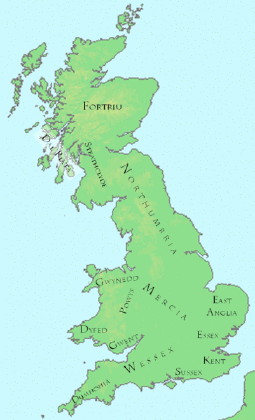|
How Counties
Came
About
Click on any of the
maps to see a larger copy
Counties can be found
throughout the old and modern world, in Europe the word county originated
from the concept that it was an area under the jurisdiction of a count.
In Britain the origins
are slightly different, in Celtic Britain and Ireland counts were called
Earls, which came from the Old Norse word Jarl, and was introduced by the
Vikings. However there is no identifiable tie up between earldoms and
counties. Instead the Anglo Saxon system involved an administrative area of
an Anglo Saxon Kingdom, a Scir. When the Normans arrived in 1066 they simply
called these areas counties, to line up with their understanding. The Scir
or as we know it now 'shire' then became an area that was controlled on
behalf of the sovereign by the 'Shire Reeve' or Sheriff.
The sheriff is still a ceremonial role in counties today.
This role
of Reeve, dates from before earlier more democratic times. In
England, a Reeve was an official elected annually by the Serfs to
supervise lands for a Lord. The Reeve himself was a Serf. He had many duties
such as making sure the Serfs started work on time and ensuring that no one
was cheating the Lord out of money. The system was introduced by the Saxons,
prior to the 7th century, and continued after the Norman conquest. The
Shire Reeve is a derivative of this acting as a servant of his Lord, in this
case the King, and be trusted to bring in the taxes and make sure all ran
smoothly. After 1066, many were Norman followers of the King, who were also
given titles and land.
The names in some cases originate from the
earlier kingdoms (Wessex, Mercia, East Anglia, Lindsey,
Kent, York…..), as in the case of Kent derives from
the Kingdom of Kent, and Essex, Sussex and Middlesex come from the East
Saxons, South Saxons and Middle Saxons. Norfolk and Suffolk were
subdivisions representing the "North Folk" and "South Folk" of the Kingdom
of East Anglia. Yorkshire is from the Viking kingdom of York. Lincolnshire
from the old kingdom of Lindsey. Other counties are named after
the rivers or towns that were important to them.
Devon, Dorset and
Somerset, derived from 'tribal' names. Historians date the transformation of
the kingdom of Wessex into the kingdom of England to 927, when King Alfred's
grandson, Aethelstan, conquered Northumbria. By 954 the conquest of the
Danelaw was complete. Thereafter, there was only one English kingdom on
English soil, and the West Saxon royal dynasty had become the first royal
dynasty of a united English kingdom.
The ancient counties took their names from
this period and was connected with its tax raising and military obligations.
Below counties you had Hundreds and this was divided into vill.
Some counties like
Cumberland, Westmorland, Lancashire, County Durham and
Northumberland were established in the 12th century, and over time some
other changes have occurred, most notably, bits of land that for historical
reasons were an island within another county, were rationalised to be in
that county. Over time
some counties have dropped the shire ending, usually where no town of the
same name exists.
Welsh
counties likewise line up largely with welsh princedoms. The border of Wales
was set in 1535, when the counties were formally defined, when it became a
part of the country of England and Wales, the act is similar to a marriage
document. Some of the border counties for example Monmouthshire was part of
England and are now a part of Wales.
Each county has its unique history for example,
Wiltshire known as Wiltunscire from the 8th century, a region of the
ancient kingdom of Wessex, the capital of which was Wilton, located where
the river Wylye is joined by the river Naddar, which goes
under the Palladian bridge in the grounds of Wilton House, on to join the
Avon by a watermill, going, through what is now Salisbury, to the sea
at Christchurch. Wilton was the crossing point over the river. Later when Sarum moved to New Sarum, later renamed Salisbury, this became a crossing
point and Wilton become bypassed. Through this period of history church
buildings occupied the location now occupied by Wilton House.
Further information
http://www.abcounties.co.uk/
http://en.wikipedia.org/wiki/County
http://en.wikipedia.org/wiki/Counties_of_the_United_Kingdom
http://en.wikipedia.org/wiki/Ceremonial_counties_of_England
http://en.wikipedia.org/wiki/Historic_counties_of_England
Old maps of counties
http://freepages.genealogy.rootsweb.com/~genmaps/
http://www.nls.uk/maps/early/counties.html
On collecting old maps
http://www.antiquemaps.com/uk/info/mapguide.htm
|

Ancient kingdoms before 1000AD |